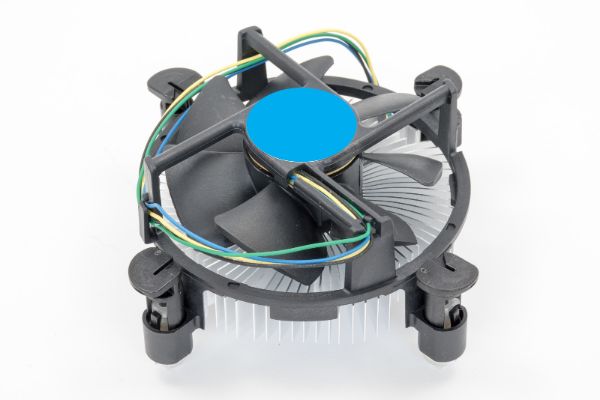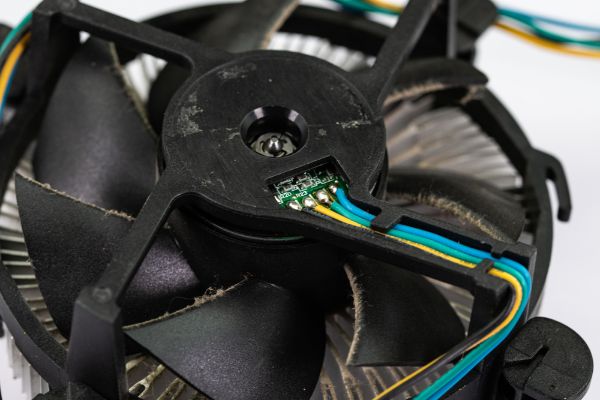Disclaimer: This post may contain affiliate links, meaning we get a small commission if you make a purchase through our links, at no cost to you. For more information, please visit our Disclaimer Page.
Modern desktop and laptop computers do a lot of work for both business and leisure. While all of the components inside these machines tend to be hidden from users and protected by casings, it is also true that some of the parts inside are delicate. The central processing unit tends to be quite robust, but it does generate plenty of heat as it is working.
If you notice that your CPU is using nearly all of its load in a program like Task Manager, it is probably true that it is heating up quite a bit. You’ll probably hear that the fan inside your computer gets louder and speeds up in conjunction with this usage, too. Heat can be bad for computer parts, but a heatsink helps to draw that excess warmth away before it can get too hot.
Some computer users wonder if heatsinks for either desktop rigs or laptops can ever go bad and need replacing. We’ll dive into that subject in this article, and we will cover whether you can replace these items yourself, too. Additionally, we’ll touch on whether you should be able to reuse a heatsink that you’ve chosen to remove from your system, which you might do for cleaning or inspection.
Table of Contents
Do Heatsinks Need To Be Replaced?
In general, you shouldn’t ever need to replace a heatsink itself. As with any kind of technology, there are always some caveats of which you should be aware, but it is unlikely for these components to need replacing.
The reason for this lies in their construction. Your typical heatsink uses aluminum and copper components in its makeup. While these metals are relatively soft, they provide excellent heat dissipation, which is the main purpose of the unit.
Additionally, the metal is still strong enough to provide a protective frame, and the heatsink is a stationary unit that doesn’t need to move any parts in order to do its job.
There are still rare occasions in which you might have to pick up a new heatsink. We will go into more details about that in the next section, but it should only be an issue if the device takes any kind of physical damage that could stop it from functioning.
Because the sink is not moving around, and because it is protected by the shell of the computer case, this should be a very rare occurrence.
If a desktop rig or laptop are dropped, banged, or jostled severely, there is a chance that the heatsink might take enough damage to warrant a replacement part.
However, it is more likely that you would damage other, more sensitive components inside the computer in this situation before the heatsink took enough damage of its own.
Can a Laptop Heatsink Go Bad?
In extremely rare cases, it is possible that the heatsink on a laptop could go bad. Much like how rare it is to replace one, it is also not common that these parts go bad. In fact, other components are more likely to go bad and need to be replaced long before anything happens to the heatsink.
All of this assumes that you are operating the laptop in normal conditions and that it is not subjected to any kind of physical damage that could crack the casing or hurt the components inside. If everything is normal, the chances of having a problem with the heatsink are extremely small.
That said, it is possible for things around the heatsink that work with it to go bad. In such cases, you’ll need to replace these parts to make sure that the heatsink can keep doing its job properly. The heatsink is part of the general cooling system of any laptop or desktop PC. As we touched on earlier, its primary purpose is to draw heat away from things like the central processor.
You can also find heatsinks working to keep graphics processors cool. When the heatsink draws buildup away from the computer part in question, it usually transfers it to a liquid or gel-like medium. In most cases, this will be thermal paste. This paste comes standard with any computer, and it is already installed and ready to work when you set up your device.
This paste, grease, or gel bridges any gaps between the sink and the chip or part it is meant to cool. It also fills in air pockets that might otherwise act as insulation that keeps heat trapped rather than letting it go. Thermal gel has a shelf life of at least a few years, and this should apply to any of it that is already inside a new computer.
Under normal circumstances, it should be able to help with heat dissipation for at least five or so years, although this is just a general guideline, and it should not be taken as a hard rule. Because of its shelf life, thermal paste can get old or dry out. When this happens, it becomes less effective, and that means that the heatsink may not be able to do its job, either. Therefore, replacing the paste from time to time is essential to helping the heatsink.
Additionally, most heatsinks are cooled by a fan or similar device. The fans are mechanical, and they run on motors that turn on when the laptop is powered up. You may hear fans get quite loud and fast if the CPU or GPU are running hot.
Although fans should last a long time, their mechanical natures mean that they can wear out as well. In order to keep the heatsink as cool as possible, it is a good idea to take a look at the fan. A fan that is running at high speeds constantly could be one that is in need of replacement. This could also be true if you never hear the fan running at all.
Can You Replace a Laptop Heatsink?
If you know that the heatsink is failing, you can replace it. The process for removing and replacing the heatsink can be tricky, however. It is best to do some preparation before you attempt to replace the heatsink yourself. Your first step should always be finding and downloading the official maintenance instructions for your laptop.
If you know the make and model, you can visit the internet to see if there are official guides related to its maintenance. The website of the manufacturer is usually the best place to start. Once you have the instructions, they may provide helpful guidelines for cleaning or replacing various parts, and the heatsink could be included here.
After you remove the heatsink by opening the laptop and taking it out, you can install a new one. However, it is important to make sure that you get a heatsink that has a thermal pad that matches the one you use already. This is why it is a good idea to get any official instructions related to your laptop. It can tell you what kind of heatsink the device uses. You should aim for a heatsink that is the same model or type as the one in the laptop already.
Can You Reuse a Heatsink?
There should be no reason you can’t reuse a heatsink after you clean it. The only problem would be if the unit itself was damaged in any way. Fluid from the pipes inside the heatsink might leak after damage or many years of use, and you would want to replace the unit in this case.
How Do I Clean My Heatsink?
You should also gather a few tools before you begin your work. The list can vary, but a screwdriver, a soft brush, extra thermal paste, a duster cloth, and oil for lubrication are all good places to start. You can also follow some general steps in order to get to and remove the heatsink, and we will provide some options that should work for most laptops.
1. You’ll need to remove the bottom panel of the laptop. Many of these computers have hidden latches that you might need to lift all around the frame using a small, delicate tool.
2. Always separate the battery cable from the motherboard before touching any other components in the computer. This is true even though the computer should be unplugged and powered down at this point.
3. The motherboard also has a fan cable that you need to disconnect. After that, you can remove the screws holding the fan and heatsink in place.
4. Lift the cooling unit up out of the laptop.
5. Use a soft brush to clean the heatsink. You might want to clean the fan blades during this process, too.
6. You can put the heatsink back in the computer, reconnect everything, and close it up. However, it is best to apply new thermal paste before you finish the process.
How Often Should I Clean My Heatsink?
There is no hard rule for how often you should clean your heatsink. However, if you are interested in replacing your thermal paste every few years or so, it isn’t a bad idea to clean the heatsink while you’re doing this task. You’ll have the computer open anyway, and you’ll be working in proximity to the heatsink.
Conclusion
Heatsinks are essential parts of any working computer, and they keep things cool so that you can spend as many hours as you might need on your device. They are powerful components with few weaknesses, but they can go bad on rare occasions. When this happens, you may need to either clean or replace the unit. It is best to do so as soon as you notice a problem with how your laptop or desktop cools itself.


